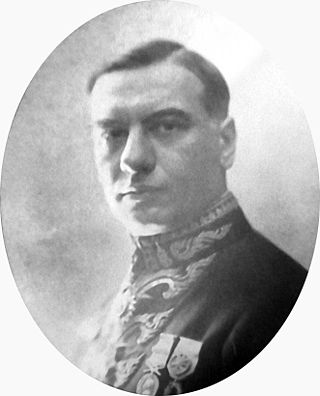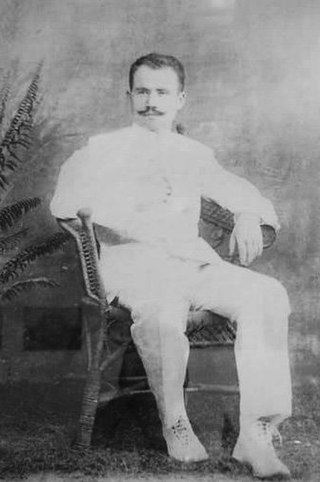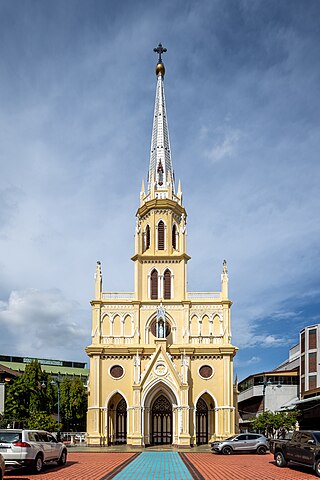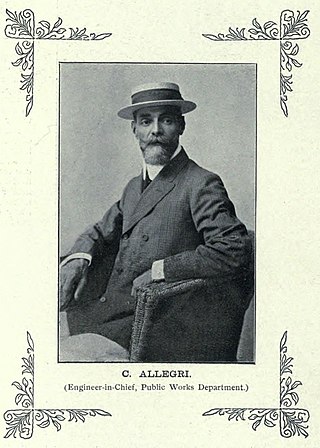
Ercole Pietro Manfredi was an Italian architect who lived and worked in early twentieth-century Siam. Born in Turin, Italy, he attended the Albertina Academy of Fine Arts before travelling to Bangkok, where he was one of many Westerners employed by the Siamese government.

Mario Tamagno was an Italian architect who worked mainly in early 20th-century Siam.
Annibale Rigotti was an Italian architect, teacher, designer and urban planner.

Museum Siam is a discovery museum that is located at Sanam Chai road in Bangkok, Thailand. The museum was established in 2007 in the former building of the Ministry of Commerce. It was created to teach the national identity and history of the people of Thailand, and their relationships with neighboring cultures. The motto of the museum is “Play + Learn = เพลิน” ; through a series of interactive exhibits, the museum shows the development of Thailand from the past to present.
The Architectural Conservation Award is given by the Association of Siamese Architects in recognition of architectural conservation efforts by both the public and private sectors in Thailand. The awards, first given in 1982 and held annually since 2004, are presented to multiple winners in three categories, namely: buildings, people/organizations, and vernacular communities.

The Bang Khun Phrom Palace is a former royal residence in Bangkok, Thailand. It served as the residence of Prince Paribatra Sukhumbandhu until his forced exile following the Siamese revolution of 1932.

The Sathon Mansion or Luang Chitchamnongwanit Mansion is a complex of historic buildings in Bangkok, Thailand. It was built in 1888 for Luang Sathonrachayut, the wealthy Chinese businessman who developed Sathon Road, and later served as the Hotel Royal, the Soviet embassy and, since 2015, a restaurant and entertainment venue for the W Bangkok hotel, known as The House on Sathorn.

The Holy Rosary Church, also known as Kalawar Church, is a Roman Catholic church in Bangkok. It is located in Samphanthawong District, on the eastern bank of the Chao Phraya River. The history of the church dates to 1769, when a group of Portuguese Catholics resettled in the area after the fall of Ayutthaya; the current church building, in Gothic Revival style, was built in 1891–97 on the site of two previous structures.

Sanan Devahastin na Ayudhya, better known by his noble title Chaophraya Thammasakmontri, was an educator, writer and senior government officer of Siam/Thailand. He served as Minister of Public Instruction from 1915–1926, and was the first President of the National Assembly, serving from 28 June – 1 September 1932 and from 15 December 1933 – 26 February 1934.

The Talat Noi Branch is Siam Commercial Bank's first permanent office, and the oldest operating bank branch in Thailand. It is located in Talat Noi Subdistrict of Bangkok's Samphanthawong District, at the periphery of Bangkok's Chinatown. The building, designed by Italian architect Annibale Rigotti in the Beaux-Arts style, was built in 1908 or 1910. It sits on the bank of the Chao Phraya River, almost next to the Holy Rosary Church, and is listed by the Fine Arts Department as an unregistered ancient monument. The building received the ASA Architectural Conservation Award in 1982, and underwent renovations in 1995.

Carlo Allegri (1862–1938) was an Italian engineer who worked extensively in Siam (Thailand) during the turn of the 19th–20th centuries. He served under the government of King Chulalongkorn for over 20 years, where he held the position of Engineer-in-Chief of the Public Works Department. He oversaw the construction of numerous roads and bridges in the country and contributed to buildings such as the Ananta Samakhom Throne Hall.

S.A.B. Intersection is formed by the intersection of Charoen Krung and Worachak with Chakkrawat roads in Bangkok's Pom Prap Sattru Phai and Samphanthawong Districts near Khlong Thom area. The boundaries of the intersection are considered to be where Worachak road ends, and where Chakkrawat road emerge.

The General Post Office, also known as the Grand Postal Building, is a historic building in the Bang Rak District of Bangkok. Opened on 24 June 1940 on the former site of the British Legation, it was designed by architects Sarot Sukkhayang and Mew Aphaiwong in a mixture of Art Deco and International Style architecture which reflected the desire of the ruling People's Party to project a modern and powerful image of the state.

Surawong Road is a road in the Bang Rak District of Bangkok, Thailand, linking Charoen Krung Road to Rama IV and forming the boundary between Suriyawong and Si Lom subdistricts. It was built at the end of the 19th century during Bangkok's period of expansion following the country's opening up to the West, and was home to many leading businesses, upper-class families, and members of the expatriate community. It was known as a Western-style nightlife entertainment district during the 1920s, and was—and still is—home to many leading hotels. The road grew as a business district along with the nearby Si Lom Road during the mid-20th century, but lagged behind in development toward the end of the century due to its limited traffic capacity. Today, it is still home to several historic landmarks, as well as many well-known restaurants.

The Chulalongkorn University Auditorium is one of the main historic buildings of Chulalongkorn University in Bangkok, Thailand. It was built during 1937–1938 and was designed by Phra Phromphichit and Phra Sarotrattananimman. The building represents one of the most major examples in the development of the applied Thai style of architecture during the People's Party government; the modernist reinforced concrete structure is combined with a traditional-Thai/Khmer–influenced layered roof and decorative elements. The building is an unregistered ancient monument, and received the ASA Architectural Conservation Award in 2002.

The First Presbyterian Church, Samray is the oldest Protestant church in the Thai capital Bangkok. Originally founded in 1849, the church was built in its current location on the western bank of the Chao Phraya River in 1857. The present building dates to 1910.

Rajini School is a private girls' school in Thailand, and one of the oldest in the country. It was founded in 1904 by Queen Saovabha Phongsri as a replacement for the recently closed Sunanthalai School, which she had previously also sponsored. The school is situated in Bangkok's Phra Nakhon District, at the southern tip of the historic inner Rattanakosin Island. Today it admits kindergarten to upper secondary students, with an enrolment of 2,861 in 2019, and is known for its traditional values. The historic Sunanthalai Building is a listed ancient monument.

Thomas Heyward Hays was an American surgeon who lived and worked in Siam, overseeing some of the country's first hospitals. He arrived in Bangkok with the Presbyterian Mission Agency, and subsequently entered government service, serving as chief physician of the Royal Siamese Navy and head of the Bangrak Hospital. He was also one of the first lecturers at the Royal Medical College.

The Embassy of France in Bangkok is the chief diplomatic mission of France in Thailand, and one of the oldest in the country. It was established as a consulate in its current location on the Chao Phraya River off Charoen Krung Road in Bangkok's Bang Rak District in 1857, following the signing of the Treaty of Friendship and Commerce which re-established diplomatic relations between the two countries the previous year. The mission was elevated to a legation in 1892 and an embassy in 1949, and supports the ambassador in promoting political, economic and cultural ties between the two countries.

The British Club is an expatriates' social club in Bangkok, Thailand. It was founded as a British gentlemen's club in 1903, and established in its current location on Surawong Road in 1910. The club's operations were disrupted by the Second World War, after which it was re-established. Today, the club features several sporting facilities, as well as dining services and function rooms in the original clubhouse, which has been recognized as an award-winning historic building, and is one of several historic buildings in Bang Rak District.


















